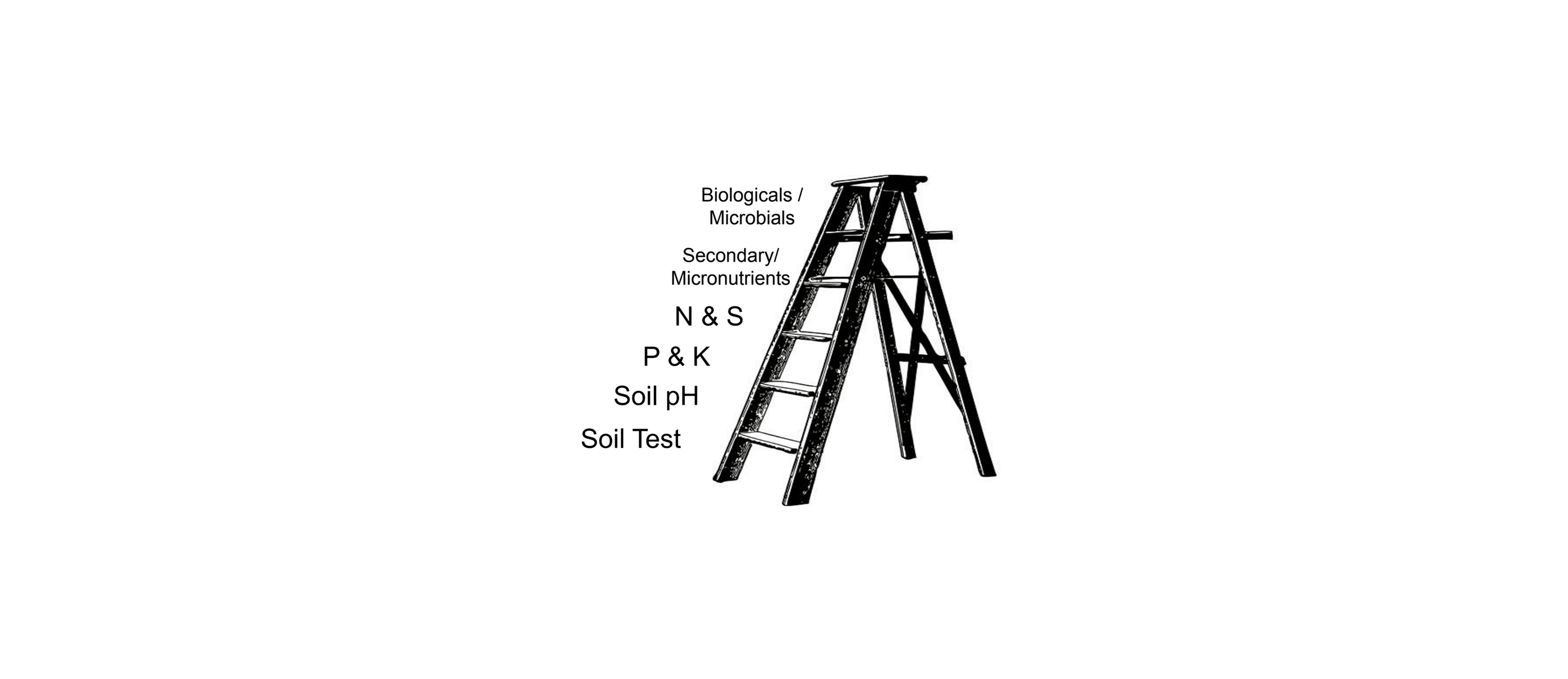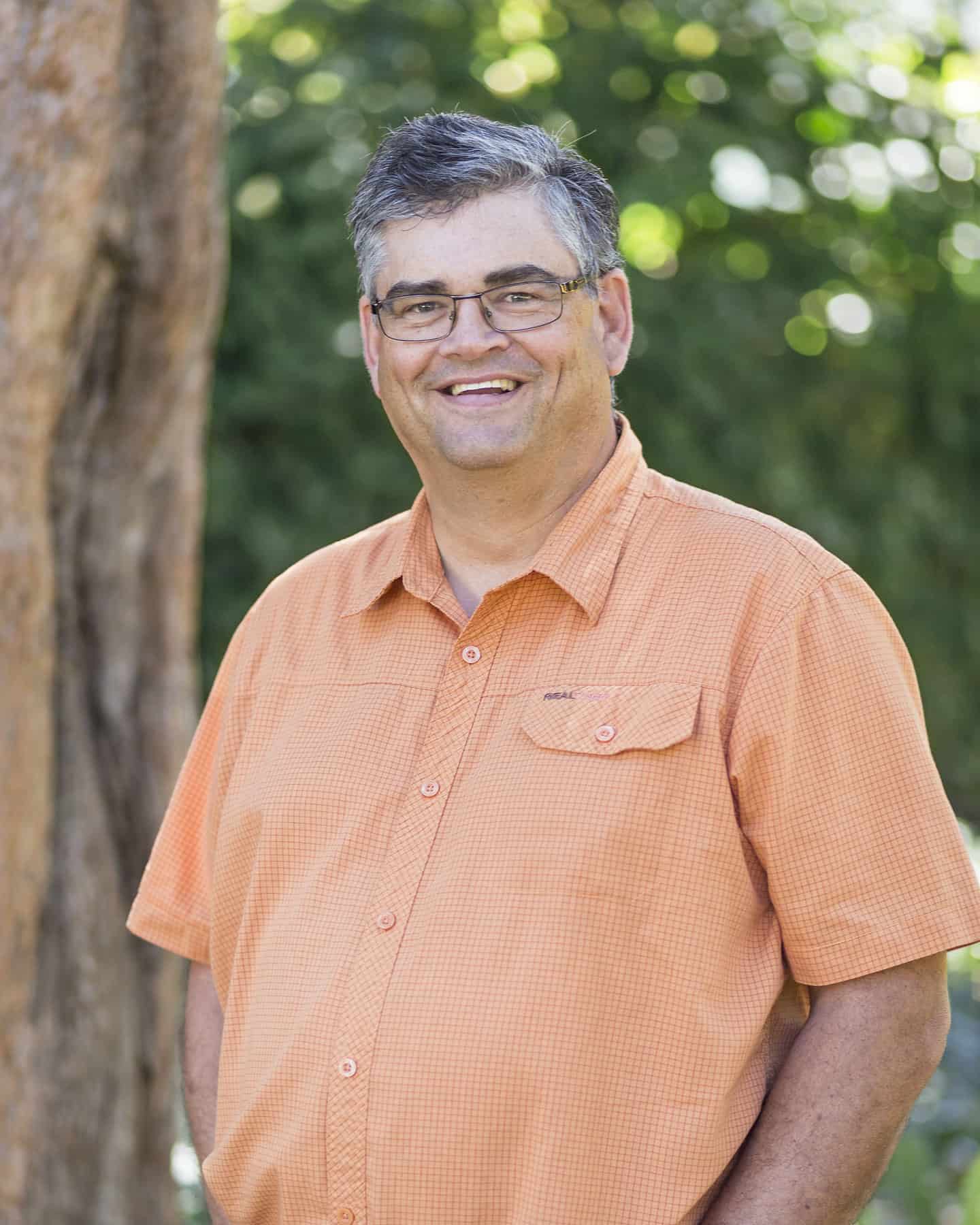One of the featured speakers at this year’s Fall Line Summit was Dr. Brian Arnall. Brian is a precision nutrient management extension specialist for Oklahoma State University, where he also teaches courses on Soil Nutrient Management and Precision Ag. At our Summit Brian shared his insights into the mechanisms surrounding basic Soil Fertility.
Brian started his presentation with establishing the importance of Soil Fertility and the steps you need to follow to optimize it. As you climb the ladder to producing the most profitable yields, the correct first step on the bottom rung of that ladder is proper Soil Testing.
Careful soil sampling is essential for an accurate fertilizer recommendation. A sample must reflect the overall or average fertility of a field, so subsequent analyses, interpretations, and fertilizations accurately represent the nutrient status of the soil. Soil fertility varies by location, slope, and past management. Brian states that one consider each of the following steps to obtain a good soil sample (see Figure):

It is possible to apply unneeded fertilizer or animal manure if the nutrient status of a field is unknown. This not only costs more money, but the excess nutrients applied may also enter water supplies and cause environmental problems. On the other hand, applying inadequate fertilizer could reduce yields, decreasing profits. Fine-tuning nutrient management will result in more efficient fertilizer use, which can increase yields, reduce costs, and potentially reduce environmental pollution.
1. Area: A composite soil sample should represent a uniform field area. Each such area should have a similar crop and fertilizer history. A soil survey map may be helpful in identifying sampling areas. Exclude small areas within a field that are obviously different. These can be sampled separately if they are large enough to warrant special treatment. One sample in general should represent no more than 40 irrigated acres or 80 dryland acres.
2. Procedure: Follow a random zig-zag pattern to get a minimum of 15 to 20 cores from the sample area. Mix these subsamples thoroughly and save one pint for analysis. Fewer subsamples taken in a given area results in less accuracy when evaluating the nutrient status of the soil.
3. Depth: Take the sample to tillage depth or about 6 inches, for routine fertility analysis. Deeper to 2 feet when monitoring N levels.
4. Time: Typically, the best time to soil test is just before each cropping season. Be sure to allow enough time for analysis and fertilizer recommendation. Once the soil is cooled off below 45 F in the Fall is a good time to soil test as well.
Soil Testing is most important to monitor levels of: Nitrogen, Phosphorous, Potassium and Soil pH
Soil acidity is a common problem limiting crop yields in many regions of North America. The most common method for correcting pH is by adding lime to the soil in amounts ranging from one-half ton to as much as four tons of effective calcium carbonate lime per acre. Lime applications could be several years apart to only a couple of years apart. Special lime formulations, like liquid lime, are only as good as the actual lime that is in them. Soil testing or having a test strip of lime is a good way of telling whether lime will help crop production. The pH of soil in continuous no-till fields should be checked every two years. When lime is needed, the same amount of lime is recommended for no-till as for conventional practices, but it may take longer to correct soil acidity in the lower portion of the rooting zone under no-till than conventional tillage system. Interestingly, many North American regions that were not concerned about acidity are now starting to see seriously low pH levels in the soil surface layer, as nitrogen being applied at or near the soil surface under no-till can produce very acidic conditions in that surface layer. This acidic soil not only affects crop growth directly but can also impact pesticide activity. When N is always surface applied, a shallow 3-inch depth soil sample should be collected every five to eight years to document surface pH. Intensive crop production can also drive down soil pH. In many regions, aluminum toxicity and the deficiency of some nutrients is associated with high acidity or low pH. Continuous no-till increases water infiltration, reduces runoff, and decreases water losses from evaporation. However, this same beneficial crop residue can contribute to nitrogen (N) loss due to volatilization if N fertilizers are broadcast over the surface of residue. However, placing N fertilizer just below the soil surface with a coulter can effectively reduce volatilization loss. Additionally, some N may be temporarily used by microorganisms as they decompose crop residue with a high C:N ratio. This may reduce N available to plants during the early stage of plant growth, but applying 1/3 to 1/2 of the total N preplant, preferably injected into the soil, should avoid residue decay-induced N deficiency. Ultimately, if managed properly, the amount of N needed for no-till should be similar to that for conventional tillage systems.
Phosphorous Management
The method used to determine phosphorus (P) availability in most USA soils is called Mehlich 3. It is expressed using an index. An index of 65 is desired for all crops, which is considered 100 percent sufficient. A soil test with 40 percent sufficiency means 40 percent of plant phosphorus needs will be supplied by the soil. The remainder must be provided by adding fertilizer. If no phosphorus is added, the yield will only be 40 percent of the potential yield. If P is deficient, apply an adequate amount of fertilizers before switching to a no-till system. Similar to conventional till, banding P fertilizers is advantageous over broadcasting in a no-till system. In fact, banding may be even more advantageous in a no-till system because P movement in the soil is very slow. Research has shown that no-till crops responded to starter fertilizers containing both N and P very well even in soils with high soil test P levels. This is probably because no-till soils with increased residue cover are cooler and wetter early in the growing season than conventionally tilled soils, which may decrease soil P availability.
Potassium Management
Like phosphorus, potassium (K) soil test estimates K availability in the soil and the test indicates a certain percent sufficiency. The optimum level will vary with crops, soil type, and other soil related factors, but an index of 250 is considered adequate for all crops except for alfalfa. Alfalfa requires an index of 350 to have an adequate K supply from the soil. Potassium can be either surface or band applied. However, the amount of K and N in the starter (banding) is determined by the distance between the fertilizer band and the seed, since both nutrients contribute to the salt index. Some crops are more sensitive to salt injury than others. Soluble fertilizers placed in a band may cause germination and/or seedling injury if rates are too high. In general, the salt index (applied N + K2O) should not exceed 30 pounds per acre for wheat and 7 pounds per acre for corn. In extremely arid regions and/or where rapid drying takes place, salt rates less than these can adversely affect wheat and corn seed germination.
Summary
Soil test at the beginning of your cropping season and on a regular yearly basis afterwards.
Lime to adjust soil pH before switching to no-till practices. Once in no-till, monitor surface pH frequently and lime to maintain proper pH if needed.
Residue can reduce N efficacy and tie up N during decay. Adjustment may be needed on N fertilization.
Base P and K fertilization rates on regular soil test recommendations.
Pay attention to salt index when band-applying fertilizers
*this article is based on Dr. Arnall’s presentation at our Summit and his newsletter publication “Soil Fertility and pH Management for No-Till”

